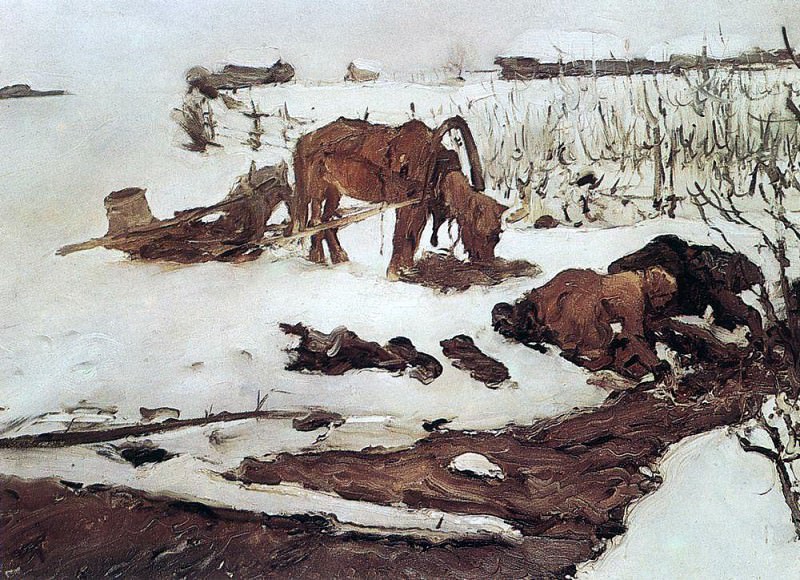Rinsing Linen (The River). 1901 Valentin Serov (1865-1911)
Valentin Serov – Rinsing Linen (The River). 1901
Edit attribution
Download full size: 1000×724 px (0,2 Mb)
Painter: Valentin Serov
This painting by Serov depicts two female figures who came to the bank of a small river to wash dirty laundry. Laundry and keeping the house clean has always been a woman’s responsibility, so we see how on a cold, winter day it is the women who rinse the laundry in the icy water. They kneel, leaning low over the water. The women are very warmly dressed - they are wearing a winter coat, boots, and shawl.
Description of Valentin Serov’s painting "Laundry Rinse"
This painting by Serov depicts two female figures who came to the bank of a small river to wash dirty laundry. Laundry and keeping the house clean has always been a woman’s responsibility, so we see how on a cold, winter day it is the women who rinse the laundry in the icy water. They kneel, leaning low over the water. The women are very warmly dressed - they are wearing a winter coat, boots, and shawl. To the right lies washed laundry, waiting for their turn.
In the foreground we see the fast-flowing river. Traditionally, laundry in Russian villages began in early spring, when the first streams thawed. With sharp strokes, Serov managed to convey the flow of the river, because standing water is not suitable for thoroughly rinsing the laundry. In the lower left corner, a log is depicted that has fallen across the river, almost forming a bridge. The river is apparently not deep, so people do not use special buildings for washing, but do the work right on the very bank of the reservoir, without fear of falling into the water.
Just behind the women is a horse. It is not a fast, frisky horse, but rather a nag tired of the difficult village life. The horse is a bit hunched, stunted, more like a pony. It obediently waits for its owners, while eating the hay that has been spread out for it. Behind the horse is the sledge on which the women arrived at the river. The image of the horse is simple and clear to everyone - this animal is a faithful helper of the peasant, so its figure organically fits into the Russian countryside landscape.
The background is practically empty, it does not distract and does not draw attention to itself - you can see only a few houses from the nearby village. This arrangement of figures in the picture emphasizes that the most important action takes place in the foreground. The artist used mainly only three colors: white, black, and brown.
Кому понравилось
Пожалуйста, подождите
На эту операцию может потребоваться несколько секунд.
Информация появится в новом окне,
если открытие новых окон не запрещено в настройках вашего браузера.
You need to login
Для работы с коллекциями – пожалуйста, войдите в аккаунт (open in new window).




















You cannot comment Why?
The subtext of the painting is deeply tied to the harsh realities of peasant life in early 20th-century Russia. The title, Rinsing Linen (The River), alludes to a specific, arduous chore. The presence of horses, essential work animals, is central to the scene. Their posture – weary, straining, some even appearing to have fallen or collapsed – conveys a sense of struggle and hardship. The cold, unforgiving environment underscores the difficulty of their labor and their lives.
The painting can be interpreted as a commentary on the physical toll of manual labor, particularly in a challenging climate. It highlights the resilience and endurance required to survive, but also the potential for exhaustion and despair. The subdued color palette and the rough, energetic brushstrokes contribute to the overall feeling of raw, unvarnished reality. Theres a quiet dignity in the depiction, even amidst the struggle, suggesting the enduring spirit of both the animals and the people they serve, who are implicitly present but unseen in this frozen landscape.